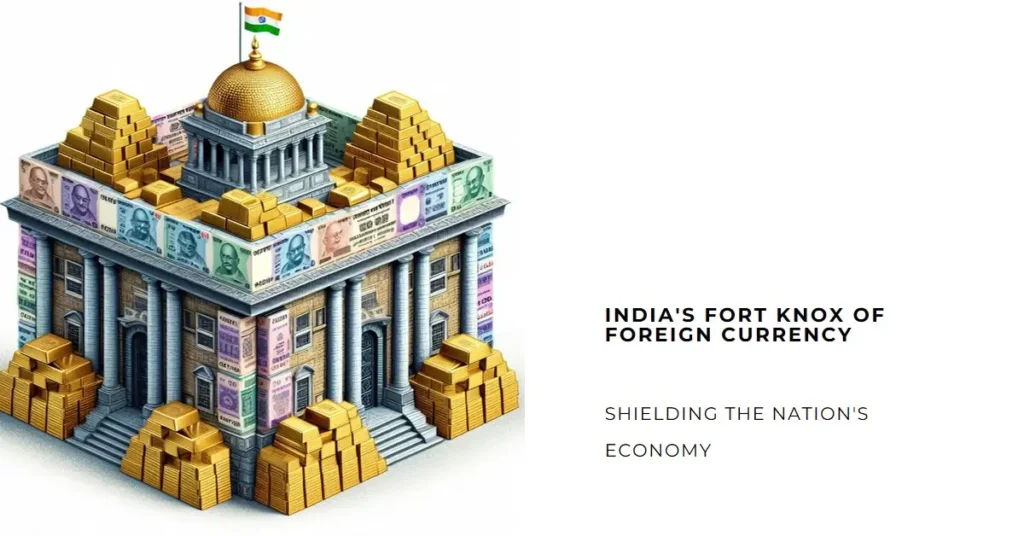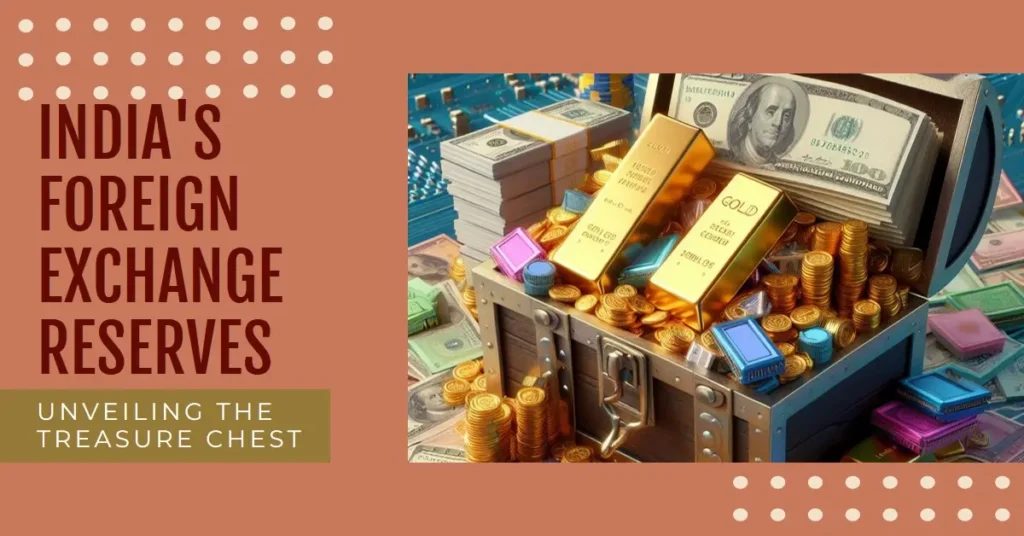India’s foreign exchange reserves hit a 2-year high! What does this mean for the economy? Explore the reasons behind the surge, potential impacts, and expert insights.
India’s Foreign Exchange Reserves: A War Chest for Economic Stability
Introduction
The recent surge in India’s foreign exchange reserves (India’s foreign exchange reserves) has grabbed headlines, sparking both optimism and cautious curiosity. With reserves reaching a two-year high of $636.1 billion as of March 8, 2024, understanding what this signifies for the Indian economy becomes crucial. This comprehensive guide delves deep into the intricacies of India’s foreign exchange reserves, exploring their composition, significance, recent trends, and future implications.
What are India’s Foreign Exchange Reserves?
Imagine a nation’s financial war chest – a stockpile of foreign currencies, gold, and other valuable financial assets held by its central bank, the Reserve Bank of India (RBI) in this case. These assets, collectively known as India’s foreign exchange reserves, act as a critical buffer for the Indian economy.
Also Read : Forex Alert: Indian Rupee Depreciation to 83.19 vs. USD – Decoding Economic Impact!
Why are Foreign Exchange Reserves Important?

India’s foreign exchange reserves play a multifaceted role in ensuring economic stability. Here’s a breakdown of their key functions:
- Maintaining Exchange Rate Stability: India’s foreign exchange reserves allow the RBI to intervene in the foreign exchange market by buying or selling foreign currencies. This helps regulate the rupee’s exchange rate, preventing sharp fluctuations that could disrupt trade and investment.
- Import Coverage: India’s foreign exchange reserves provide a crucial safety net for essential imports like fuel and medical supplies. A healthy reserve ensures the country has sufficient foreign currency to pay for these necessities, even during periods of global economic turmoil.
- Investor Confidence: India’s foreign exchange reserves signal a nation’s financial strength and ability to meet its external obligations. Robust reserves boost investor confidence, attracting foreign capital inflows and promoting economic growth.
- Manageability of External Debt: India’s foreign exchange reserves provide a cushion for servicing external debt obligations. A comfortable reserve level reassures creditors and facilitates smoother debt management.
Composition of India’s Foreign Exchange Reserves

India’s foreign exchange reserves are not a monolithic entity. They comprise various components, each playing a distinct role:
- Foreign Currency Assets (FCAs): This is the largest component, typically consisting of U.S. dollars, euros, yen, and other major currencies held in deposits with foreign central banks or invested in foreign securities.
- Gold: India’s foreign exchange reserves also include a significant amount of gold bullion, which acts as a hedge against inflation and currency depreciation.
- Special Drawing Rights (SDRs): These are reserve assets created by the International Monetary Fund (IMF) that can be exchanged for a basket of major currencies.
- Reserve Position in the IMF: This reflects India’s quota-based contribution to the IMF’s resources, which can be accessed under specific circumstances.
Also Red : Depreciation of the Indian Rupee 2023: Causes, Impact & Expert Strategies!
Understanding the Recent Rise in India’s Foreign Exchange Reserves

The recent jump in India’s foreign exchange reserves to $636.1 billion is certainly positive news. However, unpacking this rise requires a closer look at the contributing factors:
- Increased Inflows: A surge in foreign direct investments (FDI) and portfolio investments can lead to higher foreign currency inflows, contributing to the rise in reserves.
- Lower Imports: A slowdown in the Indian economy or a decline in global commodity prices can lead to reduced imports, resulting in fewer dollars flowing out and a consequent buildup of reserves.
- RBI Intervention: The RBI may strategically purchase foreign currencies in the market to manage the rupee’s exchange rate and accumulate reserves.
A Look Back: Historical Trends in India’s Foreign Exchange Reserves
India’s foreign exchange reserves have witnessed a rollercoaster ride over the years. Let’s explore some key milestones:
- Early Days: India’s foreign exchange reserves were relatively modest in the early years of independence.
- Liberalization and Growth: The economic liberalization reforms of the 1990s led to a significant increase in reserves, fueled by foreign inflows.
- Global Financial Crisis: The 2008 financial crisis triggered a global slowdown, impacting India’s foreign exchange reserves as well.
- All-Time High: In October 2021, India’s foreign exchange reserves reached a historic peak of $645 billion.
- Recent Decline and Rebound: The reserves witnessed a decline due to RBI interventions to defend the rupee against global headwinds. However, the recent surge marks a positive turnaround.
The RBI’s Role in Managing Foreign Exchange Reserves

The RBI plays a pivotal role in managing India’s foreign exchange reserves. Here’s an overview of its key strategies:
- Market Intervention: The RBI strategically intervenes in the foreign exchange market by buying or selling dollars to maintain exchange rate stability. This helps prevent excessive volatility in the rupee’s value.
- Open Market Operations: The RBI conducts open market operations by buying or selling government securities to manage liquidity in the financial system. These operations can indirectly influence India’s foreign exchange reserves by impacting foreign currency inflows and outflows.
- Foreign Currency Forward Contracts: The RBI may use forward contracts to hedge against potential exchange rate fluctuations and protect the value of India’s foreign exchange reserves.
- Forex Reserves Adequacy Ratio: The RBI monitors an internal metric called the Forex Reserves Adequacy Ratio, which measures the import cover provided by the reserves. This helps assess the adequacy of reserves in meeting import needs.
Future Implications of India’s Rising Foreign Exchange Reserves

While the recent rise in India’s foreign exchange reserves is encouraging, it’s crucial to consider its future implications:
- Maintaining Sustainability: A significant portion of the recent increase might be due to lower imports stemming from an economic slowdown. Ensuring sustainable growth in reserves through increased exports and FDI becomes crucial.
- Managing Volatility: Global economic uncertainties and currency fluctuations can still impact India’s foreign exchange reserves. The RBI’s adept management will be essential to navigate these volatilities.
- Investment Opportunities: A robust forex reserve position can open doors for strategic investments abroad, potentially boosting India’s global economic footprint.
- Policy Considerations: The RBI might reassess its intervention strategies in the foreign exchange market as India’s foreign exchange reserves reach higher levels.
Beyond the Numbers: India’s Foreign Exchange Reserves and the Global Landscape
The health of India’s foreign exchange reserves is not just an isolated domestic concern. Here’s how it interacts with the global economic landscape:
- Global Interdependence: In today’s interconnected world, the health of a nation’s foreign exchange reserves can influence global currency markets and investor confidence.
- Currency Wars: The strategic use of foreign exchange reserves by countries to manipulate their currencies can trigger unintended consequences, impacting global trade and economic stability.
- International Cooperation: Collaboration between central banks and international financial institutions is crucial to maintain global financial stability and manage potential disruptions in foreign exchange markets.
Beyond the Basics: Frequently Asked Questions about India’s Foreign Exchange Reserves
Let’s delve deeper by addressing some frequently asked questions regarding India’s foreign exchange reserves:
- What is an optimal level for India’s foreign exchange reserves? There’s no single “ideal” level. The adequacy of reserves depends on factors like import needs, external debt obligations, and global economic conditions.
- Can a high level of reserves hinder economic growth? In some cases, excessively high reserves might discourage exports as a strong currency makes exports less competitive. However, this is a complex issue with no easy answers.
- How does the composition of India’s foreign exchange reserves impact its effectiveness? A diversified reserve composition with a healthy mix of currencies and gold helps mitigate risks associated with fluctuations in any single asset class.
- What are the potential risks associated with a decline in India’s foreign exchange reserves? A significant drop in reserves could make it challenging to manage the exchange rate, pay for essential imports, and maintain investor confidence.
The Road Ahead: India’s Foreign Exchange Reserves Management in a Changing World
The management of India’s foreign exchange reserves is a dynamic process that requires continuous adaptation to a rapidly evolving global economic landscape. Here are some key considerations for the future:
- Building Resilience: India’s foreign exchange reserves management strategy should prioritize building resilience against external shocks and unforeseen economic turbulence.
- Diversification: India’s foreign exchange reserves composition should be continuously reviewed and diversified to mitigate risks associated with currency fluctuations.
- Transparency and Communication: The RBI’s communication regarding its foreign exchange reserves management strategies is crucial for maintaining market confidence and stability.
- Global Collaboration: Active participation in international forums and collaboration with other central banks is essential to address global economic challenges and foster a stable international financial system.
In conclusion, India’s foreign exchange reserves are a vital economic bulwark, safeguarding the nation’s financial stability and fostering economic growth. Understanding the composition, significance, recent trends, and future implications of these reserves empowers individuals and businesses to make informed decisions in an increasingly interconnected world. As India navigates the dynamic global economic landscape, the prudent management of its foreign exchange reserves will remain paramount to ensuring a prosperous and resilient future.
Additional Considerations and Resources for a Well-Rounded Understanding
Data Analysis and Visualization:
This guide has primarily focused on explaining the concepts surrounding India’s foreign exchange reserves. To complement this understanding, consider incorporating data analysis and visualization elements. Here are some suggestions:
- Charts and Graphs: Include charts and graphs depicting historical trends in India’s foreign exchange reserves alongside relevant economic indicators like GDP growth, import/export levels, and exchange rates. This visual representation can enhance reader comprehension and retention.
- Interactive Elements: If your blogging platform allows, explore creating interactive elements like timelines or charts that users can manipulate to explore specific timeframes or compare different components of the reserves.
Real-World Examples:
Illustrate the concepts with real-world examples to make the content more relatable and engaging. Here are some potential areas to explore:
- Impact on Businesses: Discuss how fluctuations in India’s foreign exchange reserves can impact businesses that import or export goods. Analyze specific case studies to showcase these real-world consequences.
- Government Policy Decisions: Examine how the RBI’s management of India’s foreign exchange reserves influences government policy decisions related to trade, investment, and foreign exchange regulations.
- Global Events and their Influence: Analyze how major global events, such as currency wars, trade conflicts, or economic crises, can affect India’s foreign exchange reserves and vice versa.
This post is for informational purposes only.Invest responsibly.No guarantees of results. Seek professional guidance before investing.Consult experts for personalized advice.AI-assisted content, editorially reviewed.See our terms for details.Please note that I am not a SEBI registered investment advisor. The information provided in this article is for informational and educational purposes only and should not be construed as financial advice. Always consult with a qualified and SEBI registered financial professional before making any investment decisions. .Follows Google policies.Not affiliated with Investopedia.com. investopedia.co.in Independent site.
